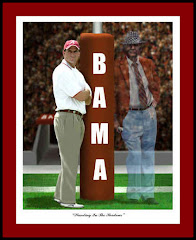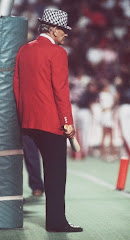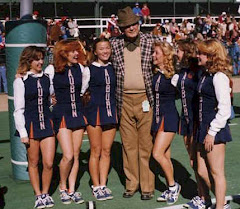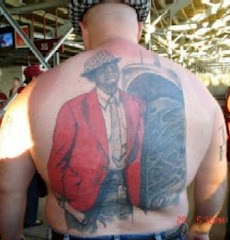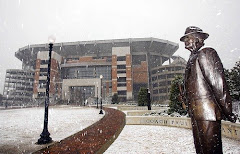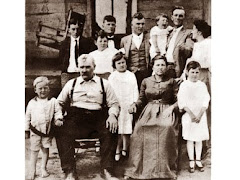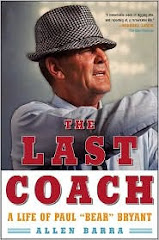

“I’d like for people to remember me as a winner, because I ain’t never been nothin but a winner.” That is one of many famous quotes from Paul “Bear” Bryant, former coach of University of Alabama football. Bryant is a hero at the University of Alabama. His legend lives deep in the walls of historical Tuscaloosa. Today, the University still shares a secret with Coach Bryant – The secret of winning! Paul “Bear” Bryant represents a rough and tenuous time in Alabama history when most of the world was looking at the Alabamians as poor and backwards. Coach Bryant provided the people of Alabama something in which they could focus their sense of pride on. Throughout his life, he was determined to show the world he was special, and he succeeded far more than he ever imagined. The pursuit of his excellence still lives with each proud fan that wears the crimson color. Bear Bryant is a symbol of hope, determination, and victory.
I grew up in a household of Alabama fans. I was a University of Alabama cheerleader for Halloween when I was four years old. My father had about 50 Alabama football shirts proudly hanging in the front of his closet. Saturdays at my house consisted of the whole family cooking out and watching football on TV. Coach Bryant’s name was respected in my house. My two brothers and I never said anything negative of his name or disrespected the legend by wearing anything that resembled orange or blue – Auburn’s rival colors. I didn’t go to an Alabama football game until my freshman year in college. It was incredibly overwhelming with the atmosphere and screaming fans. Music began to play over the jumbotron and a video of past plays started to show. Finally, at the end of the video Coach Bryant said one of his famous quotes. The crowd went wild. The fans were louder than ever. It wasn’t till then that I understood how important Bear Bryant was.
Since my family were all die-hard Alabama fans, I was always curious why Coach Bryant was such an icon. I had heard stories about him but never actually did my own research to find out how he made Alabama football a culture in itself. I wanted to know how one man could inspire so many people. I thought the best place to start my research would be the Bear Bryant Museum.
In 1981, Coach Bryant, wanted a memorial place for former players and coaches. He wanted people to remember the entire football history that started in 1892. There were various collections to remember the victories made by former coaches and players. The museum opened its doors to the public on October 8, 1988. It has grown tremendously since then. The University of Alabama previously owned it, but now it is freestanding. Coach Bryant had a vision when he came up with the concept of a museum. He wanted to incorporate tradition and honor for the players and assistant coaches who helped him set the record for the most victories by an intercollegiate coach in the Southeastern Conference. (Paul “Bear” Bryant Museum).
The museum is located on the University of Alabama campus at 300 Bryant Drive, Tuscaloosa, Alabama. Across from the Coleman Coliseum, it is dedicated to showing visitors a clear perspective of the University of Alabama collegiate athletes, history, tradition, and excellence. Their mission statement is to collect, preserve, and exhibit items, and to disseminate information related to the sports history of the University of Alabama” (Bryant Museum).
I was not sure if the museum was open year round, but to my surprise, it was. It is open 9am-4pm daily. Tours of the museum are only given if you call ahead. It was gorgeous outside and a wonderful day to learn a little bit more about Alabama football. I arrived at lunchtime. The only people in the place were the woman at the front desk, the elderly man that worked in the gift shop, and a tall, business looking man observing the artifacts.
I noticed the museum had a large variety of random artifacts. It had everything from traditions, records, past coaches, the Million-Dollar Band, songs, games, the pro-hall of fame, college hall of fame, and stadium history, a photo-gallery, exhibits, and educational information. When I first walked in the museum, I noticed a statue of Coach Bryant. The mantle beside it said, “Paul Bryant wanted to honor his players in any recognition given to his career. Here, representing four universities, are the teams he coached to 323 victories in 38 seasons.” On the left of the statue is art memorabilia created by Dee and Lionel F. Baxter Jr. I just stood there staring at the brilliant essence of the paintings for about 2 minutes. Next to that was an exhibit with a heading of “The Early Days” that showed sweaters and uniforms worn from 1892-1922. I couldn’t help from wondering how the players played with those flimsy leather helmets. They didn’t even look like they could protect a player. Early football equipment was in the center of the room. This display consisted of a leather helmet from 1900, leather shoes, a code and rule book from 1909, and a 1917 football letter pendant of Ralph Jones, who played guard from 1917- 1919. I wished I could have picked the rulebook up and read it to see how many things have changed over the years. The Million Dollar Band display was in the back left corner of the museum. Next to the display was a plaque that said, “What Paul W. Bryant was to Alabama football, COL. Butler was to Alabama’s music program and bands.”
There was one particular exhibit in the back of the room just tugged at my heartstrings. It was Bear Bryant’s office. It was completely tied off. He had a large desk, 6 pictures hanging around the room, and a plaid couch. Over the couch was a poster of the famous coach advertising coke and Golden Flake chips. His hat and coat hung neatly by his desk. What I remember the most was a picture of him with his wife and 2 children. There was a plaque on the desk by the couch that said, “For winning more games that those coached by any other individual in the history of intercollegiate football.” Next was a picture of General Douglas Macarthur. He was congratulating coach Bryant and former quarterback Pat Trammell. I was almost done with the tour when I noticed a crystal replica of coach Bryant’s houndstooth hat, produced by the internationally acclaimed crystal sculpture, Miraslav Havel. It was made at the Waterford Crystal Company of Waterford Ireland and presented to the University at the UA-Temple game in 1986. As I walked through the end of the tour, I noticed very famous paintings by Daniel A. Moore. I was finally through. Now all was left was the gift shop! There was everything from houndstooth hats, shirts, cups, chairs, and everything imaginable that has to do with Alabama Football. Too bad I had no money.
I kept walking around admiring the architecture of the building and noticed a tall, slinder man walking around looking at the exhibits. We were standing by the trophy exhibits and I started conversation. His name was Dwayne Massey. He was very interesting. He used to be a professor at West Alabama but now teaches at Ole Miss. He was at the Capstone for an interview. He said he use to play for University of Alabama former coach, Mike Dubose. He also played football for Ole Miss. He said he actually played in the 1982 game when Paul the Bear had his game that gave him the most wins of any coach in SEC history. “He was a winner,” Massey said. “There has never been a more successful coach. I can remember our mascot was a golden eagle. Well, Mr. Bryant was leaning on the goal post and our eagle went right beside him and leaned on the other side of the post. Coach Bryant just looked over at the opposing team’s mascot, took off that houndstooth hat that he wore all the time, and laid it right on that eagle’s head. The crowd went wild!” Mr. Massey was happy to talk with me. We watched a video of the legendary coach. Afterward, he said, “You know, I agree when Coach Bryant says, “I’m a teacher first. I know what he is talking about because that is how I feel being a professor and football coach. I was watching a special on him and will never forget how dedicated he was to his team. He said, “Boys, you’re not ordinary. You’re something special. I know that. If you just put a little something more into that, you can win.” Mr. Massey told me that going through the museum was like going down memory lane.
There was a young blonde woman standing in the front, as I was about to leave. She said she used to work at the museum and was just waiting on a friend to meet her. She was extremely nice and said she could tell me some more history of the place, but if I wanted to get more detail to look at the museum’s website because it had tons of information about Coach Bryant and Alabama athletics. The young lady gave me some very interesting information on the museum website as well as former Coach Bryant.
I decided to check out the museum’s website when I went home. The website was very insightful but could have been updated quite a bit more in my opinion. It had history, photo galleries, tour information, various traditions of the capstone, all the coaches up to present day, the museum’s mission statement that was quoted to me earlier, and many more miscellaneous facts. What caught my eye was under the “traditions” tab. It was a timeline and biography of the Bear
Bear Bryant’s father, Wilson Monroe Bryant was from Georgia. He moved to Arkansas when he was a young man. He met Ida May Kilgore in church and they were soon married. They settled on a small farm in Fordyce, Arkansas. The family lived in a tiny shack in a community called Moro Bottom.
Paul Bryant was born September 11, 1913. He was the 11th of 12 children. Bryant was said to be a mischievous boy. Neighbors’ said he once caused a community scandal by stealing watermelons from a neighbor’s garden. Bryant was always teased as a child for being poor and country. He would have to walk by the “city” boys and girls every Saturday after school and they would tease him about his overalls and the fact that he had to help his mother scrape up pennies because they were so poor. Bryant spoke about how Fordyce motivated him to stay strong in his 1974 autobiography, Bear, with John Underwood. He said, “I still remember the ones that did it. I didn’t want to have to go back behind that blow…or peddle through Fordyce with my mama. I was motivated by the fear of having to go back to that more than anything else” (The Life of Paul Bryant). His sister once said, “There were people who thought they were better than Paul, and I don’t think you ever get over that. He was never ashamed of where he came from or having been poor, but he never forgot the ones who belittled him and our mother. He was determined to show them he was made of something special” (The Life of Paul Bear Bryant).
Paul Bryant got the nickname “Bear” by actually wrestling a real live bear at a carnival for $1. Bryant told People magazine, “I would have wrestled King Kong for a dollar a minute.” He was in Lyric Theatre on stage when a man revealed the bear. Bryant and the bear wrestled around on stage until the bear bit his ear. Bryant’s sister said, “You should have seen him jump off that stage when he realized that thing had bit him. He was brave enough to get up there and wrestle that bear, but he wasn’t about to let it eat him alive (The Life of Paul Bear Bryant). The bear and its owner left without paying Bryant his dollar. “Paul was awful mad about that man cheating him out of his dollar, because a dollar was a lot of money,” said his cousin Dean Kilgore (The Life of Paul Bear Bryant).
Bryant started playing football in the 8th grade and earned All-State honors. He also led Fordyce High School to the state championship. Jack Benham, Bryant’s former teammate, said, “The coach liked to use him as a model: ‘Here, watch Bryant show you how to block.’ And Bryant would knock a guy five yards off the line.” “All I had was football,” Bryant later said. “I hung on as though it were life and death, and it was” (The life of Paul Bear Bryant). Football gave Bryant an identity. He wasn’t the poor kid from Fordyce anymore. People were cheering his name. People respected him. The University of Alabama recruiters were at one of the games and were actually interested two of Bryan’s teammates, the Jordan twins. Instead, they found Bryant. He went to finish high school in Tuscaloosa, Alabama, and received an athletic scholarship to the Capstone. While he was living in Alabama, he received a telegram that said his father had passed away. Bryant went through many obstacles but never quit. To him, quitting was the ultimate act of weakness (The Life of Paul Bear Bryant).
While Bryant had a tremendous football career at Alabama, he found another love worth pursuing, Mary Harmon. They met in front of the University supply store while attending Alabama. She had dark hair and was thought of as having a class and elegance. Bryant asked Mary Harmon out and she told him it would have to be a few weeks as she scrolled through the pages of her black book. The Bear just stood there.” Shoot, honey, I’m talking about tonight,” he said. He just turned and walked away. Bryant had a phone call later that night. It was Miss Mary Harmon. She decided she could rearrange her schedule and wanted to know if he still wanted to see her that night. They were married on June 2, 1935. They kept it a secret because he was scared of losing his scholarship. Nobody knew about the marriage for 5 months until Mary found out she was pregnant. When she told Paul, he decided that he wanted to coach football to support his family. The Bryant’s daughter, Mae Martin, was born that March. His son would be born a few years later (The Life of Bryant).
Bryant soon graduated college. He was an assistant coach at Alabama for 4 years and then decided to coach for Vanderbilt for 2 years. The Navy sent Bryant to Uruguay in WWII. When he came back he became the head coach for Maryland University. He had various coaching jobs at Kentucky, Texas A&M, and soon returned to the University of Alabama. Bryant said he signed a 10-year contract because returning to the alma mater was like he had “heard mama calling.” Alabama dominated college football in the 60’s. Even after he was accused of being racist for not having African American players on the team, Bryant still resumed winning National Championships and leading his team to victories. He soon welcomed 2 African American players to play and the commotion soon stopped. In 1983, Bryant retired. 28 days later, he died. Bryant had 323 career victories. He also had 6 National Championships at Alabama. “He wasn’t just a coach,” former USC coach John McKay said. “He was THE coach.”
I grew up in a household of Alabama fans. I was a University of Alabama cheerleader for Halloween when I was four years old. My father had about 50 Alabama football shirts proudly hanging in the front of his closet. Saturdays at my house consisted of the whole family cooking out and watching football on TV. Coach Bryant’s name was respected in my house. My two brothers and I never said anything negative of his name or disrespected the legend by wearing anything that resembled orange or blue – Auburn’s rival colors. I didn’t go to an Alabama football game until my freshman year in college. It was incredibly overwhelming with the atmosphere and screaming fans. Music began to play over the jumbotron and a video of past plays started to show. Finally, at the end of the video Coach Bryant said one of his famous quotes. The crowd went wild. The fans were louder than ever. It wasn’t till then that I understood how important Bear Bryant was.
Since my family were all die-hard Alabama fans, I was always curious why Coach Bryant was such an icon. I had heard stories about him but never actually did my own research to find out how he made Alabama football a culture in itself. I wanted to know how one man could inspire so many people. I thought the best place to start my research would be the Bear Bryant Museum.
In 1981, Coach Bryant, wanted a memorial place for former players and coaches. He wanted people to remember the entire football history that started in 1892. There were various collections to remember the victories made by former coaches and players. The museum opened its doors to the public on October 8, 1988. It has grown tremendously since then. The University of Alabama previously owned it, but now it is freestanding. Coach Bryant had a vision when he came up with the concept of a museum. He wanted to incorporate tradition and honor for the players and assistant coaches who helped him set the record for the most victories by an intercollegiate coach in the Southeastern Conference. (Paul “Bear” Bryant Museum).
The museum is located on the University of Alabama campus at 300 Bryant Drive, Tuscaloosa, Alabama. Across from the Coleman Coliseum, it is dedicated to showing visitors a clear perspective of the University of Alabama collegiate athletes, history, tradition, and excellence. Their mission statement is to collect, preserve, and exhibit items, and to disseminate information related to the sports history of the University of Alabama” (Bryant Museum).
I was not sure if the museum was open year round, but to my surprise, it was. It is open 9am-4pm daily. Tours of the museum are only given if you call ahead. It was gorgeous outside and a wonderful day to learn a little bit more about Alabama football. I arrived at lunchtime. The only people in the place were the woman at the front desk, the elderly man that worked in the gift shop, and a tall, business looking man observing the artifacts.
I noticed the museum had a large variety of random artifacts. It had everything from traditions, records, past coaches, the Million-Dollar Band, songs, games, the pro-hall of fame, college hall of fame, and stadium history, a photo-gallery, exhibits, and educational information. When I first walked in the museum, I noticed a statue of Coach Bryant. The mantle beside it said, “Paul Bryant wanted to honor his players in any recognition given to his career. Here, representing four universities, are the teams he coached to 323 victories in 38 seasons.” On the left of the statue is art memorabilia created by Dee and Lionel F. Baxter Jr. I just stood there staring at the brilliant essence of the paintings for about 2 minutes. Next to that was an exhibit with a heading of “The Early Days” that showed sweaters and uniforms worn from 1892-1922. I couldn’t help from wondering how the players played with those flimsy leather helmets. They didn’t even look like they could protect a player. Early football equipment was in the center of the room. This display consisted of a leather helmet from 1900, leather shoes, a code and rule book from 1909, and a 1917 football letter pendant of Ralph Jones, who played guard from 1917- 1919. I wished I could have picked the rulebook up and read it to see how many things have changed over the years. The Million Dollar Band display was in the back left corner of the museum. Next to the display was a plaque that said, “What Paul W. Bryant was to Alabama football, COL. Butler was to Alabama’s music program and bands.”
There was one particular exhibit in the back of the room just tugged at my heartstrings. It was Bear Bryant’s office. It was completely tied off. He had a large desk, 6 pictures hanging around the room, and a plaid couch. Over the couch was a poster of the famous coach advertising coke and Golden Flake chips. His hat and coat hung neatly by his desk. What I remember the most was a picture of him with his wife and 2 children. There was a plaque on the desk by the couch that said, “For winning more games that those coached by any other individual in the history of intercollegiate football.” Next was a picture of General Douglas Macarthur. He was congratulating coach Bryant and former quarterback Pat Trammell. I was almost done with the tour when I noticed a crystal replica of coach Bryant’s houndstooth hat, produced by the internationally acclaimed crystal sculpture, Miraslav Havel. It was made at the Waterford Crystal Company of Waterford Ireland and presented to the University at the UA-Temple game in 1986. As I walked through the end of the tour, I noticed very famous paintings by Daniel A. Moore. I was finally through. Now all was left was the gift shop! There was everything from houndstooth hats, shirts, cups, chairs, and everything imaginable that has to do with Alabama Football. Too bad I had no money.
I kept walking around admiring the architecture of the building and noticed a tall, slinder man walking around looking at the exhibits. We were standing by the trophy exhibits and I started conversation. His name was Dwayne Massey. He was very interesting. He used to be a professor at West Alabama but now teaches at Ole Miss. He was at the Capstone for an interview. He said he use to play for University of Alabama former coach, Mike Dubose. He also played football for Ole Miss. He said he actually played in the 1982 game when Paul the Bear had his game that gave him the most wins of any coach in SEC history. “He was a winner,” Massey said. “There has never been a more successful coach. I can remember our mascot was a golden eagle. Well, Mr. Bryant was leaning on the goal post and our eagle went right beside him and leaned on the other side of the post. Coach Bryant just looked over at the opposing team’s mascot, took off that houndstooth hat that he wore all the time, and laid it right on that eagle’s head. The crowd went wild!” Mr. Massey was happy to talk with me. We watched a video of the legendary coach. Afterward, he said, “You know, I agree when Coach Bryant says, “I’m a teacher first. I know what he is talking about because that is how I feel being a professor and football coach. I was watching a special on him and will never forget how dedicated he was to his team. He said, “Boys, you’re not ordinary. You’re something special. I know that. If you just put a little something more into that, you can win.” Mr. Massey told me that going through the museum was like going down memory lane.
There was a young blonde woman standing in the front, as I was about to leave. She said she used to work at the museum and was just waiting on a friend to meet her. She was extremely nice and said she could tell me some more history of the place, but if I wanted to get more detail to look at the museum’s website because it had tons of information about Coach Bryant and Alabama athletics. The young lady gave me some very interesting information on the museum website as well as former Coach Bryant.
I decided to check out the museum’s website when I went home. The website was very insightful but could have been updated quite a bit more in my opinion. It had history, photo galleries, tour information, various traditions of the capstone, all the coaches up to present day, the museum’s mission statement that was quoted to me earlier, and many more miscellaneous facts. What caught my eye was under the “traditions” tab. It was a timeline and biography of the Bear
Bear Bryant’s father, Wilson Monroe Bryant was from Georgia. He moved to Arkansas when he was a young man. He met Ida May Kilgore in church and they were soon married. They settled on a small farm in Fordyce, Arkansas. The family lived in a tiny shack in a community called Moro Bottom.
Paul Bryant was born September 11, 1913. He was the 11th of 12 children. Bryant was said to be a mischievous boy. Neighbors’ said he once caused a community scandal by stealing watermelons from a neighbor’s garden. Bryant was always teased as a child for being poor and country. He would have to walk by the “city” boys and girls every Saturday after school and they would tease him about his overalls and the fact that he had to help his mother scrape up pennies because they were so poor. Bryant spoke about how Fordyce motivated him to stay strong in his 1974 autobiography, Bear, with John Underwood. He said, “I still remember the ones that did it. I didn’t want to have to go back behind that blow…or peddle through Fordyce with my mama. I was motivated by the fear of having to go back to that more than anything else” (The Life of Paul Bryant). His sister once said, “There were people who thought they were better than Paul, and I don’t think you ever get over that. He was never ashamed of where he came from or having been poor, but he never forgot the ones who belittled him and our mother. He was determined to show them he was made of something special” (The Life of Paul Bear Bryant).
Paul Bryant got the nickname “Bear” by actually wrestling a real live bear at a carnival for $1. Bryant told People magazine, “I would have wrestled King Kong for a dollar a minute.” He was in Lyric Theatre on stage when a man revealed the bear. Bryant and the bear wrestled around on stage until the bear bit his ear. Bryant’s sister said, “You should have seen him jump off that stage when he realized that thing had bit him. He was brave enough to get up there and wrestle that bear, but he wasn’t about to let it eat him alive (The Life of Paul Bear Bryant). The bear and its owner left without paying Bryant his dollar. “Paul was awful mad about that man cheating him out of his dollar, because a dollar was a lot of money,” said his cousin Dean Kilgore (The Life of Paul Bear Bryant).
Bryant started playing football in the 8th grade and earned All-State honors. He also led Fordyce High School to the state championship. Jack Benham, Bryant’s former teammate, said, “The coach liked to use him as a model: ‘Here, watch Bryant show you how to block.’ And Bryant would knock a guy five yards off the line.” “All I had was football,” Bryant later said. “I hung on as though it were life and death, and it was” (The life of Paul Bear Bryant). Football gave Bryant an identity. He wasn’t the poor kid from Fordyce anymore. People were cheering his name. People respected him. The University of Alabama recruiters were at one of the games and were actually interested two of Bryan’s teammates, the Jordan twins. Instead, they found Bryant. He went to finish high school in Tuscaloosa, Alabama, and received an athletic scholarship to the Capstone. While he was living in Alabama, he received a telegram that said his father had passed away. Bryant went through many obstacles but never quit. To him, quitting was the ultimate act of weakness (The Life of Paul Bear Bryant).
While Bryant had a tremendous football career at Alabama, he found another love worth pursuing, Mary Harmon. They met in front of the University supply store while attending Alabama. She had dark hair and was thought of as having a class and elegance. Bryant asked Mary Harmon out and she told him it would have to be a few weeks as she scrolled through the pages of her black book. The Bear just stood there.” Shoot, honey, I’m talking about tonight,” he said. He just turned and walked away. Bryant had a phone call later that night. It was Miss Mary Harmon. She decided she could rearrange her schedule and wanted to know if he still wanted to see her that night. They were married on June 2, 1935. They kept it a secret because he was scared of losing his scholarship. Nobody knew about the marriage for 5 months until Mary found out she was pregnant. When she told Paul, he decided that he wanted to coach football to support his family. The Bryant’s daughter, Mae Martin, was born that March. His son would be born a few years later (The Life of Bryant).
Bryant soon graduated college. He was an assistant coach at Alabama for 4 years and then decided to coach for Vanderbilt for 2 years. The Navy sent Bryant to Uruguay in WWII. When he came back he became the head coach for Maryland University. He had various coaching jobs at Kentucky, Texas A&M, and soon returned to the University of Alabama. Bryant said he signed a 10-year contract because returning to the alma mater was like he had “heard mama calling.” Alabama dominated college football in the 60’s. Even after he was accused of being racist for not having African American players on the team, Bryant still resumed winning National Championships and leading his team to victories. He soon welcomed 2 African American players to play and the commotion soon stopped. In 1983, Bryant retired. 28 days later, he died. Bryant had 323 career victories. He also had 6 National Championships at Alabama. “He wasn’t just a coach,” former USC coach John McKay said. “He was THE coach.”



